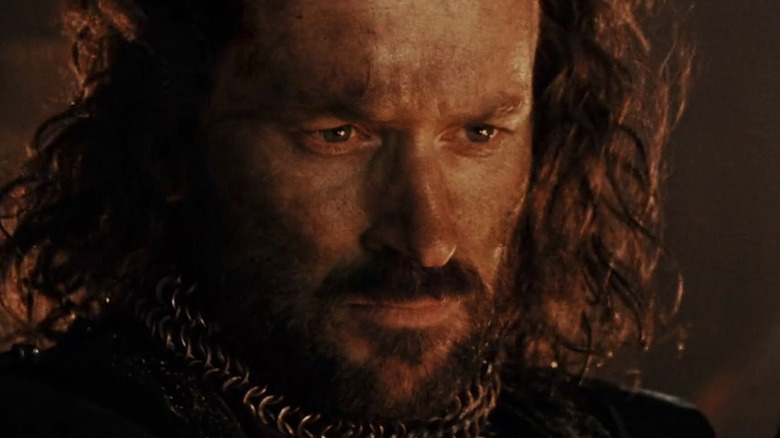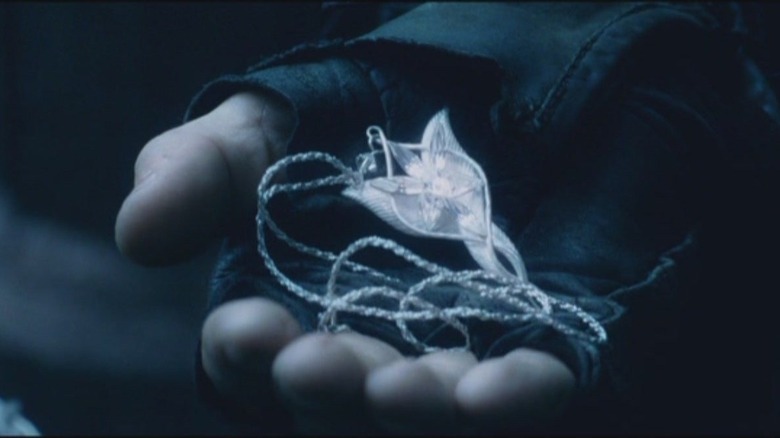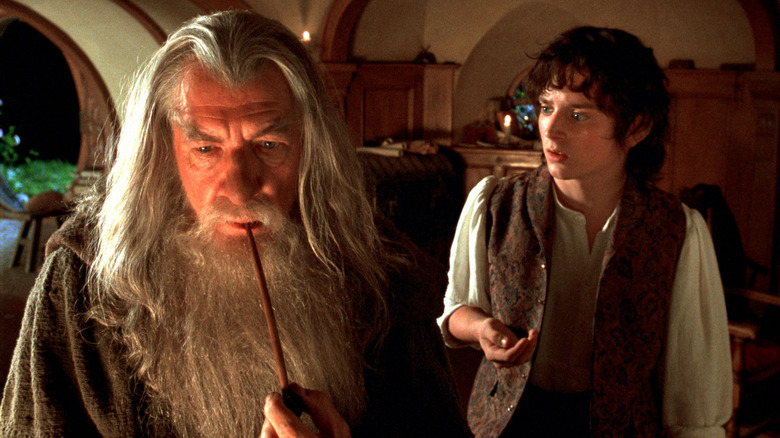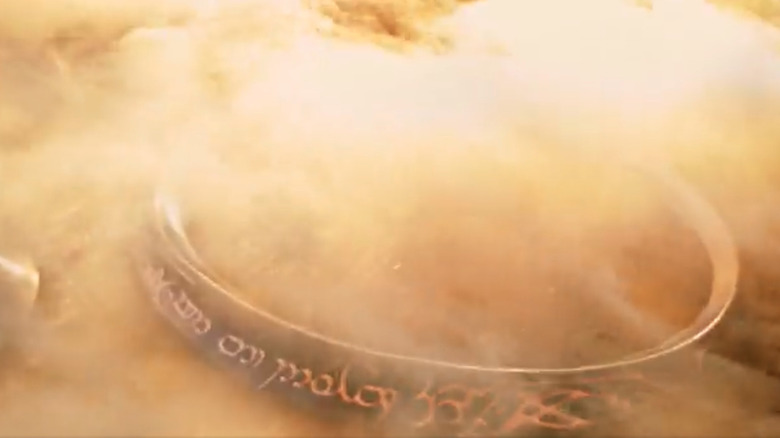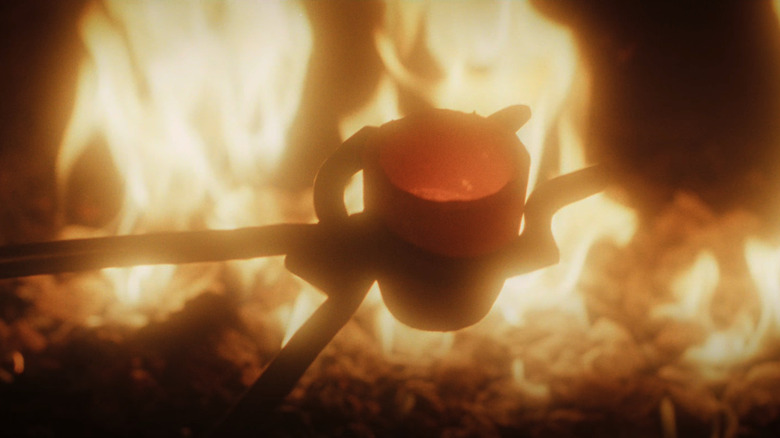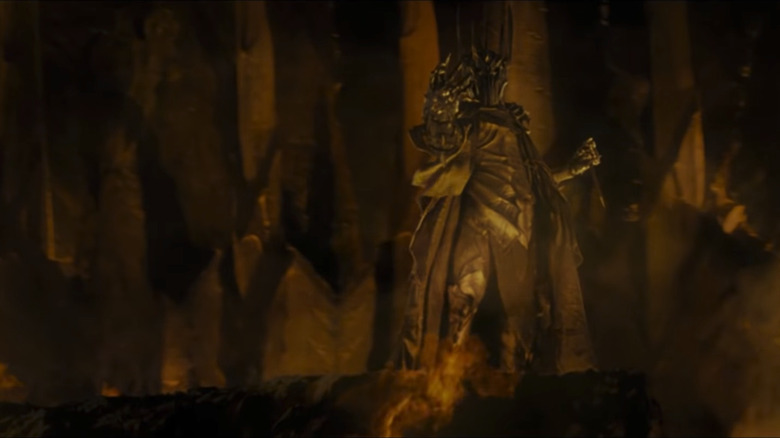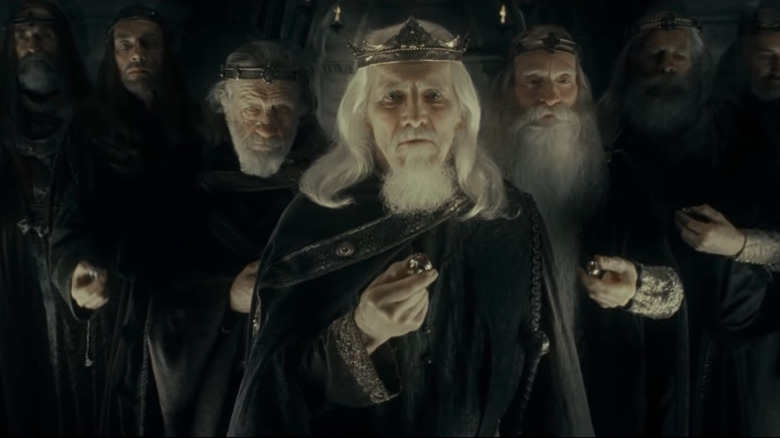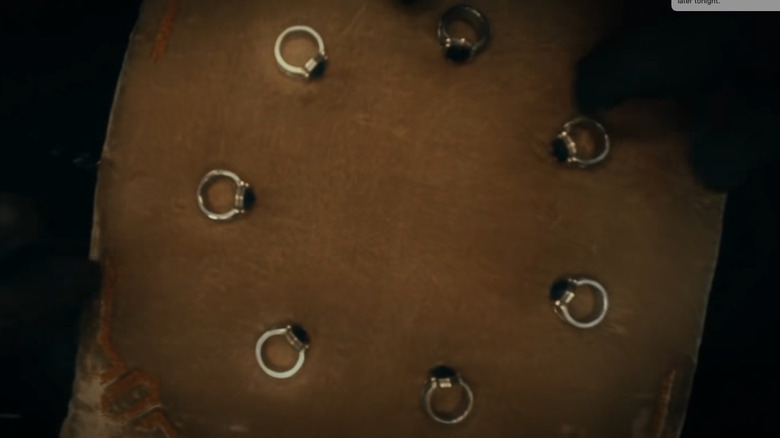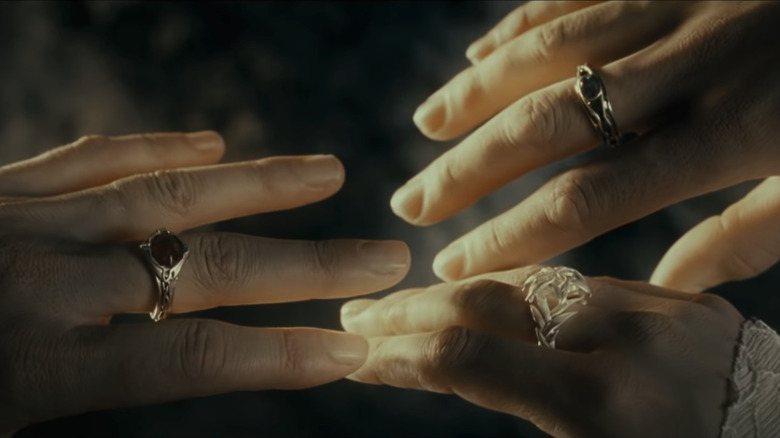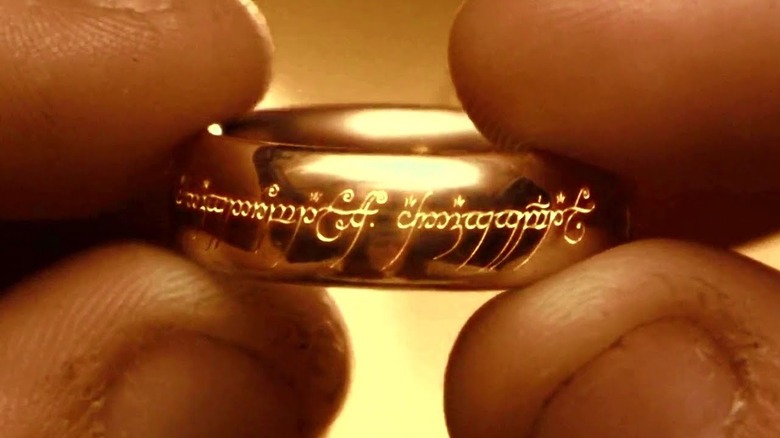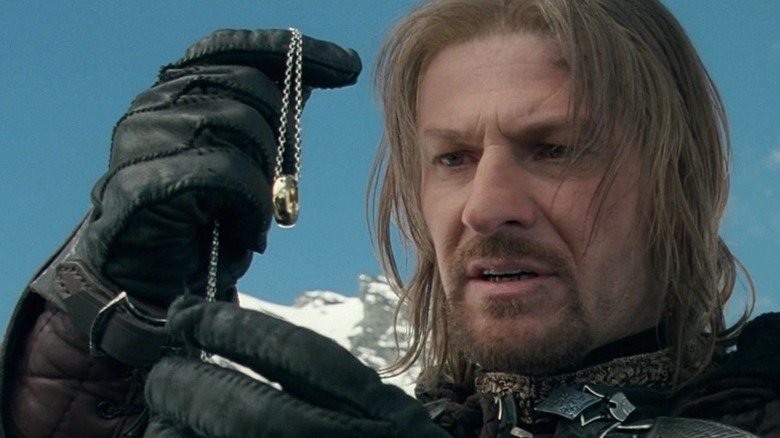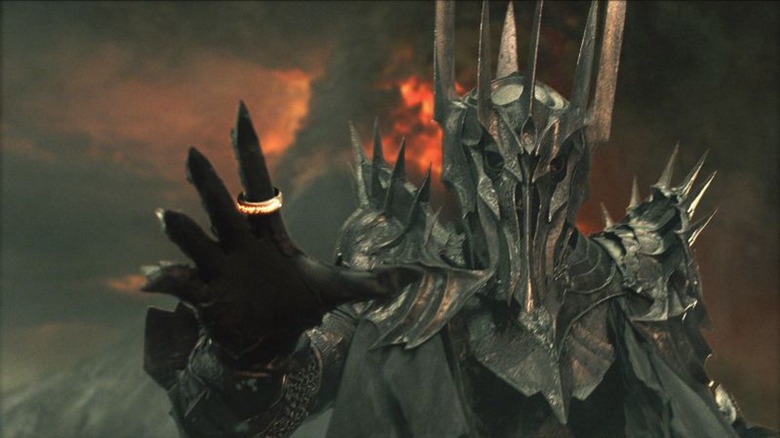Tolkien's Rings Of Power Explained
When Middle-earth is mentioned, a few things tend to come to mind. Hobbits, the Shire, epic storytelling ... and rings, of course. Lots of rings. "The Hobbit" kicks things off by having Bilbo stumble across a magic ring on his adventures. This turns out to be the One Ring, chief possession of the Dark Lord Sauron. When Bilbo bequeaths the terrifying trinket to his cousin Frodo, it sparks the cascade of events that take place in "The Lord of the Rings" (which literally has the word "ring" in the title).
Throughout that adventure, we run into Elven Rings wielded by powerful beings, Black Riders wearing rings, and even the mention of some Dwarven rings that never quite see the light of day. If you dig into the later source material published after J.R.R. Tolkien's death, you find even more info about rings — particularly about their forging during the Second Age the author envisioned for his Middle-earth. In fact, it's a topic that Amazon Studios is geared up to tell over the course of several seasons with their "The Lord of the Rings: The Rings of Power" series.
With so much ring lore going around, we thought it was about time we dug into a detailed breakdown of just what each of the rings is, how they actually work, and that age-old question of why Sauron would pour so much of his power into an object that he could — and does — lose. This is Tolkien's rings of power explained.
The role of jewelry in Middle-earth
In order to properly appreciate a conversation about something as seemingly trivial as rings, it's important to start with a quick overview of how important jewelry, in general, is presented in Tolkien's writings. You don't have to get far in the author's works to realize that precious metals and stones are really important for this guy.
"The Silmarillion" is literally named after three powerful gems that glow with their own light and spark a multi-century war between the Elves and the first Dark Lord, Morgoth. "The Lord of the Rings" also has jewelry in the title itself and refers to Sauron's "One Ring to rule them all." There are nineteen additional Rings of Power.
And then there are the numerous additional "low-profile" necklaces, scepters, rings, gems, and other trinkets that pop up regularly in the text. Aragorn's heirloom, the Ring of Barahir, is important. In Peter Jackson's films, Arwen gives her precious necklace to Aragorn. Thorin goes mad looking for the Arkenstone in "The Hobbit." In the appendix to "The Return of the King," we even hear about an ancient king of the Rohirrim who kills a dragon and then sends a necklace made from its teeth as an insult to the local Dwarves who claim the monster's treasure.
This obsession with jewelry lines up with Tolkien's focus on ancient tales, where possessions like these play a central role in many stories. For all the bedazzled fun, though, there's no doubt that rings have a particularly important part to play in the author's world.
The lesser rings
Before we officially unpack the Rings of Power, we need to point one more thing out: those Rings are not the only magical rings in Middle-earth. While Tolkien doesn't talk about them in detail, he makes it very clear that there are other rings besides the "big twenty."
There are a couple of places where Tolkien mentions other rings. The most obvious of these comes at the beginning of the "The Fellowship of the Ring" when Gandalf explains the backstory of the rings to Frodo and breaks the news to the frightened Hobbit that his little ring is the One Ring that Sauron is avidly pursuing.
The scene takes place in Bag End, where Gandalf calmly explains that "In Eregion long ago many Elven-rings were made, magic rings as you call them, and they were, of course, of various kinds: some more potent and some less." The wizard goes on to say, "The lesser rings were only essays in the craft before it was full-grown, and to the Elven-smiths they were but trifles — yet still to my mind dangerous for mortals." The wizard ends with the ominous line, "But the Great Rings, the Rings of Power, they were perilous."
So, while the focal point here is the Rings of Power, they aren't the only rings in town. There are other, lesser rings out there. Nevertheless, it's the main Rings that are the definitively "perilous" items that play a huge role in the later history of Middle-earth.
The Ring-Verse
While there are lots of pieces of jewelry and plenty of rings flying around the pages of Tolkien's writings, there's no doubt that the Rings of Power are some of his most precious artifacts. And there's no better place to start a deep dive on the Rings of Power than with the Ring Verse itself.
This is the famous poem that breaks down what rings belong to which people groups. Gandalf quotes part of the verse twice in "The Fellowship of the Ring" film, first in the common speech at Bag End and then in the Black Speech at the Council of Elrond. What's more, Amazon Studio's upcoming show quotes the other part of the poem in its title reveal promo.
This is the verse that starts with "Three Rings for the Elven-kings under the sky..." It ultimately references twenty items: three rings for the Elves, seven for the Dwarves, nine for Men, and the One Ring for Sauron. These collectively make up the 20 Rings of Power.
After listing the twenty rings, the poem darkly ends with the trio of lines, "One Ring to rule them all, One Ring to find them, One Ring to bring them all and in the darkness bind them in the Land of Mordor where the Shadows lie." This is the bedrock for all of Tolkien's Ring-related writings. The best part? According to "The Lord of the Rings: A Reader's Companion," (via Tolkien Gateway) Tolkien said that he thought of the Ring Verse while taking a bath.
The forging of the Rings of Power
One of the first questions that we need to answer is where on earth all of these powerful rings come from. Seriously, how do a bunch of rings end up unevenly distributed between the various races of Middle-earth? In predictable fashion, Tolkien has provided a significant amount of information about this seemingly minor detail via a story that starts back in the Second Age of Middle-Earth history.
At the beginning of that age, Sauron takes over the role of the "Dark Lord" from his master Morgoth. At first, he lays low for several centuries. Then he starts to make his first moves. He quietly builds his strength and chooses Mordor as his stomping ground. But things don't move quickly enough, so he puts on an attractive physical appearance (he's a powerful spirit, so he can do that kind of thing), calls himself "Annatar, the Lord of Gifts," and then visits the Elves and tries to worm his way into their affections by offering his very real wisdom and skill as a craftsman.
One group of Elves in an area called Eregion loves this Annatar dude, and their leader, Celebrimbor, soaks up everything that Sauron is willing to teach. Eventually, the Elven lord and his guild of craftsmen team up with Sauron — er, Annatar — and they all start forging some magic rings. These definitely include what become the nine rings for Mortal Men and most likely all seven Dwarf rings, too. Of course, at this point, they're all considered Elven-rings.
Sauron conquers and distributes the Rings
When sixteen of the Rings of Power are forged, Sauron sneaks back to Mordor and makes the One Ring to rule them all. In the meantime, Celebrimbor goes on to create the Three Elven Rings all on his own — i.e. Sauron has nothing to do with their creation and never touches them. This gives them a pure element that isn't present with the others. Even so, Celebrimbor couldn't have made these without Sauron's teaching, and "The Silmarillion" states that, "yet they also were subject to the One."
As soon as Sauron puts on his new Ring, the Elves wearing their rings become aware of him and take their rings off, refusing to be controlled. Sauron responds by attacking Eregion and seizing the nine Rings. He tortures Celebrimbor and, before he dies, the Elven lord reveals where seven of the others are. However, he never tells Sauron where he sent the Three Elven Rings. They stay well-hidden and safe.
Once Sauron has most of the Rings of Power, he distributes them to various Men and Dwarves that he wants to dominate with his will. The Dwarves end up too stubborn to control, but their rings still corrupt their hearts and make them obsessed with treasure. Men are much easier to sway, and they become some of Sauron's most feared servants. This sets up the long-term situation of the Rings of Power that continues on into the Third Age.
The Nine Rings for Mortal Men
Sauron's greatest success is with the Nine Rings. These Rings of Power are given to a group of men, who become the Dark Lord's most feared servants. "The Silmarillion" explains the extraordinary powers of this group of wraiths, by stating that "They could walk, if they would, unseen by all eyes in this world beneath the sun, and they could see things in worlds invisible to mortal men..."
As they walk between the worlds of spirit and physical reality, though, these men slowly lose themselves. The text says "one by one, sooner or later...they fell under the thraldom of the ring that they bore and under the domination of the One..." Once this happens, they become permanently invisible. They embody darkness and their voices are filled with death.
The ringwraiths remain Sauron's fiercely loyal servants throughout their artificially long lifetimes. They are led by the Witch-king of Angmar and the group operates as an extension of the Lord of the Rings right until the moment when the One Ring is destroyed.
Seven Rings for the Dwarf-lords
While we hear a lot about the Rings for Men and Elves, not much is said about the Dwarven rings. That's because the Dwarves aren't interested in being dominated by anyone, good or bad. In fact, throughout "The Silmarillion," they consistently switch between the roles of protagonists and antagonists, depending on the situation.
That said, when Sauron gives seven of them some fancy Rings of Power, it doesn't have quite the effect that he hoped. "The Silmarillion" says that "The Dwarves indeed proved tough and hard to tame...They used their rings only for the getting of wealth..." "The Return of the King" also states, "The only power over them that the Rings wielded was to inflame their hearts with a greed of gold and precious things...and they were filled with wrath and desire for vengeance on all who deprived them." There are seven famous "Hoards" of treasure that the Dwarves create — and guess what piece of jewelry is rumored to be at the heart of each horde? A golden ring.
"The Return of the King" also tells us that the Dwarves can't be reduced to shadows, their wills can't be enslaved, and their lives aren't affected by their rings. Even so, the Dwarven stubbornness ultimately leads to the demise of their rings. Sauron recovers three of them, and the remaining four are devoured by Dragons. While this isn't quite what Sauron planned, "The Silmarillion" does say that "wrath and an over-mastering greed of gold were kindled in their hearts, of which evil enough after came to the profit of Sauron."
Three Rings for the Elven-kings
Next up we have the Three Elven Rings. These are special in multiple ways. First off, they are the only Rings of Power that are definitively forged without Sauron. He never touches them, and they are pure — even though the One Ring is still ultimately able to dominate them. When the One Ring is lost, though, the Elven Rings can be used for their original purpose, which is very different from the other rings. "The Silmarillion" explains that the Three could "ward off the decays of time and postpone the weariness of the world." They are instruments of preservation and healing. They're also by far the most "magical" rings — by reputation, at least — and are used to create spiritually infused geographic regions of life and hope,
The Elven Rings pass through a few owners, but by the end of the Third Age, they're kept by three people. Galadriel guards Nenya, the Ring of Water. Elrond keeps Vilya, the Ring of Air. Gandalf is eventually given Narya, the Ring of Fire. These Rings are often used to create centers of peace and protection — think Lothlorien and Rivendell — and Sauron greatly covets their unsullied power, even though he's never able to capture them.
Tolkien does make it clear that, in spite of their disconnect from Sauron's tampering, the One Ring is powerful enough to dominate the Three, as well. In fact, in "The Lord of the Rings," it explains that if the Dark Lord gets the One Ring, all of the work that had been done with the Three Rings would be laid bare.
One Ring to rule them all
Finally, we have the top dog, the cat's pajamas, the pièce de résistance: the One Ring. This is the ultimate piece in the Middle-earth jewelry box. It isn't just a Ring of Power, like the others. Sauron literally infuses it with a bunch of his own native power to give it the strength to dominate the others.
"The Fellowship of the Ring" describes the high-stakes nature of the One Ring by saying, "He only needs the One; for he made that Ring himself, it is his, and he let a great part of his own former power pass into it, so that he could rule all the others."
Gigantic power plays aside, the One Ring has quite a few features worth pointing out. The obvious one is that it makes its wearer invisible. Not only that, it brings them into the spiritual realm, too. It also gives them an understanding of different languages and can extend their lives indefinitely.
More than all the other rings, the One Ring is also able to take care of itself. It can sense its master's call and respond in very direct ways, like changing sizes. Its lust is also so strong that it can overcome the will of anyone who possesses it.
Ring Power at work
Each of the Rings of Power has its own story, powerful properties, and elements of good or evil. However, the actual way that the Rings work is a bit of a mystery. As we've already seen from the breakdown of each of the different groups of rings, the way that they impacted their owners varies. Dwarves are too stubborn to turn invisible. Men become creatures of ghostly terror. Elves are able to influence their environments — but they don't turn invisible.
While their impact is different, though, there's no doubt that the Rings of Power enhance the abilities of their wearers. Sometimes this is subtle, such as making it easier for the Dwarves to cultivate their wealth. At other times, it's very direct, like Bilbo turning invisible to fight giant spiders in Mirkwood. Throughout his writing about magic rings, though, Tolkien never seems to codify a specific set of rules that they operate under. Instead, he lets their physical manifestations of power hint at a much larger, more impressive spiritual element that takes place behind the scenes.
The one theme that is consistent across all of the Rings, though, is their domination and draw toward the One Ring. This is even true for the "safer" Elven Rings. And the Rings of Men and Dwarves? They're literally cursed and perverted by Sauron. "The Silmarillion," says that "they betrayed in the end all those that used them." In "The Fellowship of the Ring" Gandalf also grimly states that for anyone who uses one of the Great Rings, "sooner or later the dark power will devour him."
Why take the chance?
The last question that we need to answer here is why Sauron makes the One Ring in the first place. Many critics have pointed out that it seems like a bone-headed move for Sauron to put his power into something that he could lose so easily. And, on the surface, that argument makes sense.
However, Tolkien gives some pretty solid reasons for why the Dark Lord would try this method of domination. For instance, in "The Silmarillion," it points out that the Rings of Power were bound up with the One Ring, "to be subject wholly to it and to last only so long as it too should last." At another point in the book, it also explains Sauron's motivation in connecting himself to the One Ring by explaining that as the Elves made the Rings of Power, "Sauron guided their labours, and he was aware of all that they did; for his desire was to set a bond upon the Elves and to bring them under his vigilance."
Sauron isn't just pouring his power into an overpowered weapon that makes him invisible. He wants to use the One Ring to dominate the wills of his enemies — without the need to physically conquer them in the first place. This is very similar to the original Dark Lord, Morgoth, who pours so much of his spiritual power into his dark schemes, that eventually he becomes permanently bound to the physical earth.
Forging the One Ring gives Sauron a huge chance to fast-track his domination — even if it also sets the stage for his ultimate fall.
